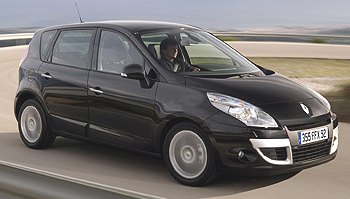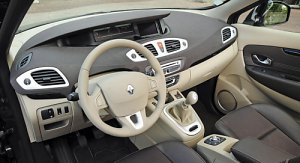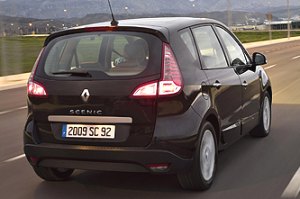|
|
|
| Published
on 30
Jun
2009 |
All rights reserved.
|
|
|

|
Like Macintosh or Palm, the brand
effect of Scenic has been fading out as time goes by...
|
13 years ago,
Renault
Scenic
pioneered a trend of small MPVs, or in its own words, Multi-Activity
Vehicles (MAV). The original Scenic sold hot in the European market,
attracting more than 200,000 units of sales annually and became a
symbol of successful innovation. However, like Macintosh or Palm, the
brand effect of Scenic has been fading out as time goes by. Entering
the 3rd generation, it can hardly sell by its image. Fortunately,
Renault has made enough improvement to the new car. Not only it becomes
better to drive, it is also more comfortable, cheaper to buy and to
run. The latter is very important to budget buyers. While rivals
Citroen C4 Picasso and Peugeot 3008 / 5008 try to go upmarket, Renault
makes the Scenic more down-to-earth by reducing its prices, extending
service intervals and equipping it with fuel-sipping engines. This
sounds right in the current economic recession.
As always, the Scenic is derived from Megane to boost economy of scale.
The underpinnings of both cars are basically the same, including
powertrains, suspensions, steering and electronics. The bottle is
different, of course. Scenic is longer than Megane in both overall
length (+50mm) and wheelbase (+62mm). It is also wider (by 37mm), but
the most significant difference is height, which is 1471mm vs 1678mm.
Unsurprisingly, the latter is put in good use to enhance headroom, to
raise seating position hence freeing up legroom for all passengers. In
standard 5-seater form, the Scenic offers the best accommodation in the
class, especially when the three individual back seats slide to the
rearmost position. If you have a big family, you can choose the
long-wheelbase 7-seat Grand Scenic, but its second and third row are
more compromised.

|
More so than the Scenic II, Scenic III
has a high-quality cabin.
|
More
so than the Scenic II, Scenic III has a high-quality cabin. Soft-touch
plastics are standard on the dashboard top, unlike some Japanese MPVs
that still employ hard ones. A light color scheme and large glass area
brighten the ambience. There are lots of storage cubbies, glovebox,
drawers etc., and the luggage area is big. Seats are multi-adjustable,
though there are a few ergonomic flaws – just as any typical French
cars. The biggest problem are the rear seats, which can flip forward
but not fold into the floor. This somewhat limit its luggage carrying
ability. Strangely, the pioneer of MAV refused to follow the market
trend to adopt fold-flat rear seats. Sometimes French are too ergo.
Renault used to be weak in engines. Following the introduction of a
small turbocharged petrol and updated diesels, its weakness has become
its strength. The Nissan-sourced 1.4-liter VVT light-pressure turbo
engine is a credible replacement for a conventional 2-liter engine, as
it provides superior mid-range torque to cope with the extra weight of
Scenic. It is refined and frugal too. The homegrown 105hp 1.5dCi turbo
diesel is also gusty and refined, while new 2.0dCi offers a surprising
160 horsepower and 280 lb-ft of torque. You don’t need to look beyond
these three engines.
 |
For a car so tall, you should admire
its limited body roll in corners.
|
In terms of chassis dynamics, the new Scenic sits between
the sporty Ford C-Max and the comfort-oriented C4 Picasso. For a car so
tall, you should admire its limited body roll in corners. This is
achieved by using stiffer springs, anti-roll bars and bushings. Softer
damping compensates part of the loss in ride quality, resulting in a
generally compliant ride except on bumpy surfaces. Thanks to a
stiffened front subframe, the steering is more precise, although its
weighting remains artificial. On highway, the cabin is well insulated
from road and wind noise.
All these merits mean the new Scenic remains a credible choice in the
ever growing small MPV segment. To me, it is probably too safe, too
middle-of-the-road. Without showing any new innovations or distinctive
character, the Scenic is unlikely to revive its once sparkling image.
|
Verdict:     |
|
|
|
|
|
|
|
|
|
|
Scenic 1.5 dCi
|
2009
|
| Front-engined,
FWD |
| Steel monocoque |
| Mainly steel |
| 4344 / 1845 / 1678 mm |
| 2703 mm |
Inline-4, diesel
|
| 1461 cc |
SOHC 8 valves
|
VTG turbo
|
CDI
|
| 105 hp |
| 177 lbft |
| 6-speed manual |
F: strut
R: torsion-beam
|
| - |
| 205/60R16 |
1385 kg
|
| 112 mph (c) |
11.5 (c)
|
| - |
|
Scenic 1.4 TCe
|
2009
|
| Front-engined,
FWD |
| Steel monocoque |
| Mainly steel |
| 4344 / 1845 / 1678 mm |
| 2703 mm |
Inline-4
|
| 1397 cc |
DOHC 16 valves, VVT
|
Turbo
|
-
|
| 130 hp |
| 140 lbft |
| 6-speed manual |
F: strut
R: torsion-beam
|
| - |
| 205/60R16 |
1320 kg
|
| 118 mph (c) |
9.9 (c)
|
| - |
|
Scenic 2.0 dCi
|
2009
|
| Front-engined,
FWD |
| Steel monocoque |
| Mainly steel |
| 4344 / 1845 / 1678 mm |
| 2703 mm |
Inline-4, diesel
|
| 1995 cc |
DOHC 16 valves
|
VTG turbo
|
CDI
|
| 160 hp |
| 280 lbft |
| 6-speed manual |
F: strut
R: torsion-beam
|
| - |
| 225/50R17 |
1520 kg
|
| 127 mph (c) |
8.6 (c)
|
| - |
|
|
|
|
|
Performance
tested by: -
|
|
|
|
|
|
|
Scenic 1.5 dCi
|
2013
|
| Front-engined,
FWD |
| Steel monocoque |
| Mainly steel |
| 4366 / 1845 / 1640 mm |
| 2702 mm |
Inline-4, diesel
|
| 1461 cc |
SOHC 8 valves
|
VTG turbo
|
CDI
|
| 110 hp |
| 192 lbft |
| 6-speed manual |
F: strut
R: torsion-beam
|
| - |
| 205/60R16 |
-
|
| 112 mph (c) |
11.8 (est)
|
| - |
|
Scenic 1.2 TCe
|
2013
|
| Front-engined,
FWD |
| Steel monocoque |
| Mainly steel |
| 4366 / 1845 / 1640 mm |
| 2702 mm |
Inline-4
|
| 1198 cc |
DOHC 16 valves, DVVT
|
Turbo
|
DI
|
| 130 hp |
| 151 lbft |
| 6-speed manual |
F: strut
R: torsion-beam
|
| - |
| 205/55R17 |
-
|
| 118 mph (c) |
10.7 (c)
|
| - |
|
Grand Scenic 1.6 dCi
|
2013
|
| Front-engined,
FWD |
| Steel monocoque |
| Mainly steel |
| 4573 / 1845 / 1645 mm |
| 2770 mm |
Inline-4, diesel
|
| 1598 cc |
DOHC 16 valves
|
VTG turbo
|
CDI
|
| 130 hp |
| 236 lbft |
| 6-speed manual |
F: strut
R: torsion-beam
|
| - |
| 205/60R16 |
-
|
| 121 mph (c) |
10.4 (c)
|
| - |
|
|
|
|
|
| Performance
tested by: - |
|
|
|
|
|
|
|
|
Copyright©
1997-2014
by Mark Wan @ AutoZine
|
|